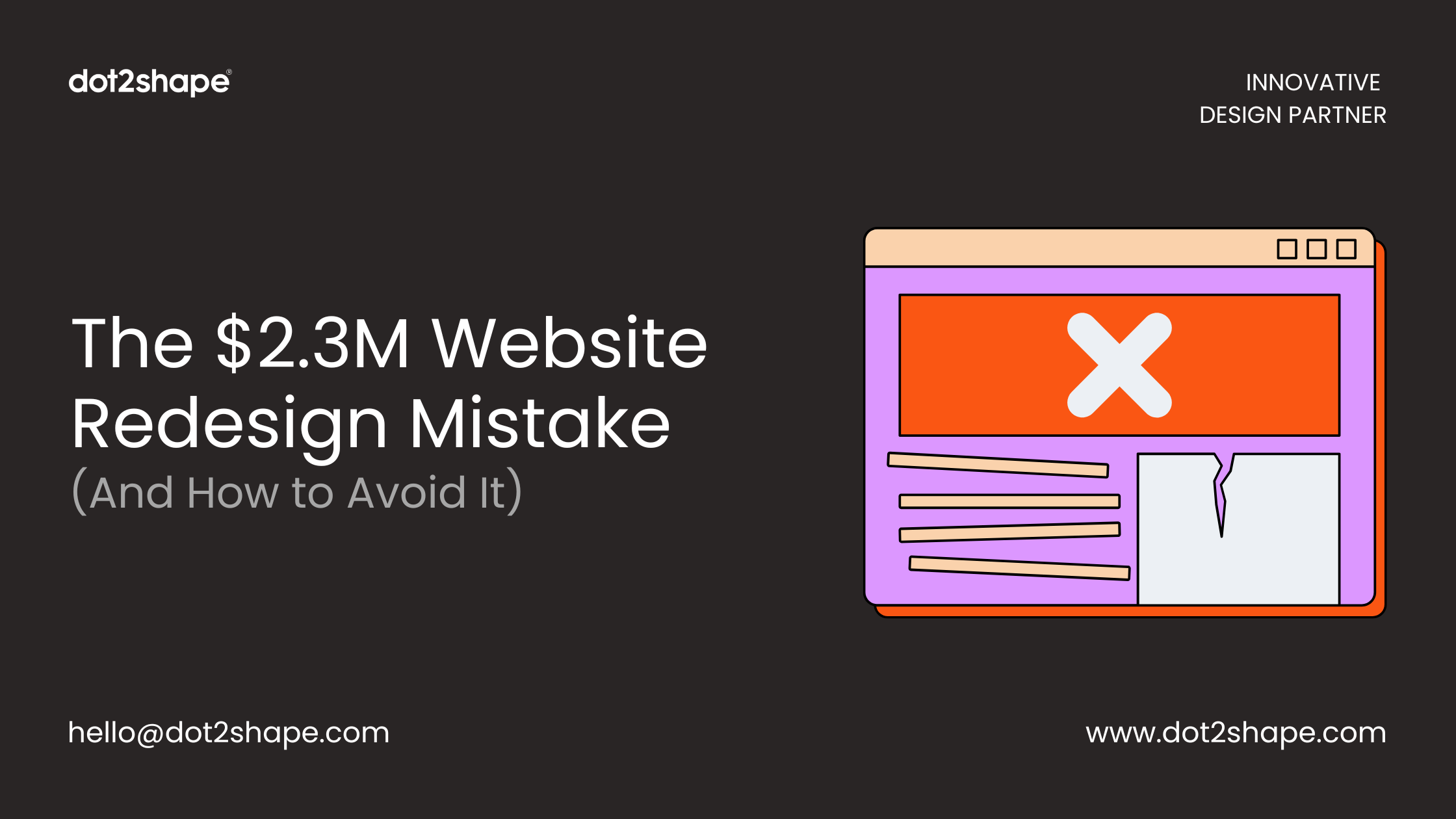In 2023, a Fortune 500 retail company launched what seemed like a perfect website redesign sleek visuals, cutting-edge functionality, and a mobile-first approach. Six months later, they faced a devastating reality website redesign mistake costs had spiraled to $2.3 million, while conversion rates plummeted 34% and annual revenue dropped by $18 million. This catastrophic design mistake represents one of the most expensive lessons in modern digital marketing.
The stakes for website redesign projects have never been higher. A typical web design agency charges around $5,000 to $75,000 for website redesign, but the hidden costs of failure can reach millions. Understanding how to avoid these critical Website redesign mistakes while maximizing ROI design has become essential for business survival in today’s competitive digital landscape.
The Anatomy of Multi-Million Dollar Design Disasters
Website redesign failures follow predictable patterns that savvy business leaders can identify and prevent. The most expensive mistakes stem from fundamental misunderstandings about user experience optimization, conversion rate optimization, and web design strategy. These failures cascade through every aspect of digital marketing, destroying carefully built brand equity and customer acquisition systems.
The Hidden Cost Structure of Failed Redesigns
Beyond the obvious website redesign cost, failed projects generate massive hidden expenses:
Direct Financial Losses:
- Lost revenue from decreased conversions (typically 15-45% drops)
- Emergency fixes and website maintenance costs
- Extended project timelines requiring additional development resources
- SEO recovery expenses from traffic and ranking losses
Indirect Business Impact:
- Damaged brand reputation and customer trust
- Competitive disadvantage during critical market periods
- Team productivity losses from firefighting mode operations
- Opportunity costs from delayed digital marketing initiatives
The $2.3 million figure represents just the tip of the iceberg the full business impact often exceeds $10-15 million over three years when accounting for lost market opportunities and customer lifetime value erosion.
The Five Deadliest Website Redesign Mistakes
1. Ignoring Data-Driven Design Decisions
The most catastrophic design mistakes occur when teams prioritize aesthetic preferences over user behavior analytics and performance metrics. 53.8% of website designers believe that not having a design that is responsive to all screen sizes is a primary reason for a website redesign. Other common reasons include low conversion rate (80.8%), high bounce rate (65.4%), and poor UX (61.5%).
Prevention Strategy:
- Conduct comprehensive website analytics audits before starting
- Implement A/B testing frameworks for all major design elements
- Use heat mapping tools to understand actual user behavior patterns
- Establish baseline performance metrics for accurate ROI measurement
2. Neglecting Mobile-First User Experience
Mobile optimization failures represent the fastest path to redesign disaster. With mobile traffic dominating web usage, responsive design isn’t optional it’s survival. Companies that ignore mobile UX best practices see immediate traffic and conversion losses.
Critical Mobile Design Elements:
- Page speed optimization under 3 seconds
- Touch-friendly navigation and interactive elements
- Progressive web app functionality for enhanced performance
- Mobile checkout optimization for e-commerce sites
3. Breaking SEO and Content Architecture
SEO disasters during website migrations can destroy years of organic traffic growth. The most expensive mistakes involve losing URL structure, breaking internal linking, and eliminating high-performing content without proper redirects.
SEO Protection Checklist:
- Complete technical SEO audits before launch
- Implement comprehensive 301 redirect strategies
- Preserve all high-value content and conversion paths
- Maintain page speed optimization and Core Web Vitals scores
4. Insufficient User Testing and Feedback Integration
Launching redesigns without extensive user testing guarantees expensive post-launch problems. Usability testing, focus groups, and beta testing programs identify critical issues before they impact live traffic.
Testing Framework Components:
- Prototype testing with target user segments
- Conversion funnel analysis for key user journeys
- Accessibility compliance testing and validation
- Cross-browser compatibility verification across devices
5. Poor Project Management and Scope Control
Project scope creep and inadequate timeline management transform reasonable website redesign costs into budget-busting nightmares. Clear project requirements, realistic timelines, and stakeholder alignment prevent costly delays and revisions.
Building ROI-Focused Design Strategies
Successful website redesigns deliver measurable business value through strategic planning and execution. ROI design principles ensure every design decision contributes to specific business objectives while minimizing implementation risks.
Establishing Success Metrics and KPI Frameworks
Design ROI measurement requires comprehensive tracking of both leading and lagging indicators:
Primary Success Metrics:
- Conversion rate improvements across all major funnels
- Average order value increases for e-commerce sites
- Lead generation quantity and quality improvements
- Customer acquisition cost reductions through better UX
Supporting Performance Indicators:
- Page load speed improvements and Core Web Vitals scores
- Bounce rate reductions and session duration increases
- Mobile usability scores and responsive design performance
- Search engine rankings maintenance and improvement
Data-Driven Design Decision Making
Modern web design strategy leverages sophisticated analytics and user research to guide every design choice. This approach eliminates guesswork and ensures design investments generate predictable returns.
Analytics-Informed Design Process:
- User journey mapping based on actual behavior data
- Heat map analysis revealing engagement patterns and pain points
- Conversion funnel optimization targeting specific improvement opportunities
- Competitive analysis identifying market advantages and differentiation opportunities
Technology Stack Optimization for Maximum ROI
Website performance optimization directly impacts conversion rates and search engine rankings. Choosing the right content management system, hosting infrastructure, and development frameworks determines long-term success and maintenance costs.
Performance-First Technology Decisions
Website speed optimization affects every business metric from user experience to SEO rankings:
Core Technology Considerations:
- Content delivery network implementation for global performance
- Database optimization and caching strategies for scalability
- Image optimization and lazy loading for faster page speeds
- Third-party integration management to prevent performance degradation
Scalable Architecture Planning
Future-proofing website architecture prevents expensive rebuilds and supports business growth:
Scalability Framework Elements:
- Modular design systems enabling rapid feature additions
- API-first architecture supporting omnichannel experiences
- Security frameworks protecting against evolving threats
- Integration capabilities connecting marketing and sales tools
Cost Management and Budget Optimization
Smart website redesign cost management balances quality outcomes with financial responsibility. Understanding true project costs and ROI timelines helps leaders make informed investment decisions.
Realistic Budget Planning and Allocation
A simpler website redesign can run anywhere from $15,000 to $30,000 depending on the size of the site, whereas websites with a large page count, custom functionality, and more unique needs can cost between $40,000 and $75,000 or more. Website redesign costs can range from $3,000 to $150,000, depending on the provider and size of the website.
Budget Allocation Framework:
- Strategy and planning: 15-20% of total budget
- Design and user experience: 25-30% of investment
- Development and implementation: 35-40% of costs
- Testing and optimization: 10-15% of budget
- Launch and post-launch support: 10-15% allocation
ROI Timeline Expectations and Measurement
Website redesign ROI typically materializes over 12-18 months, with initial improvements visible within 90 days of launch. Understanding these timelines helps set realistic expectations and measure success appropriately.
ROI Milestone Framework:
- 30 days: Technical performance and user experience improvements
- 90 days: Conversion rate changes and traffic quality shifts
- 6 months: Lead generation and sales pipeline impact
- 12+ months: Full customer lifetime value and market share effects
Frequently Asked Questions (FAQs)
Q: What is the average cost of a website redesign in 2025?
A: Website redesign costs vary significantly by scope and complexity, ranging from $15,000-$30,000 for simple redesigns to $40,000-$75,000+ for complex, custom websites. Enterprise-level redesigns can exceed $150,000 depending on functionality requirements and integration complexity.
Q: How long should a website redesign take from start to finish?
A: Most website redesign projects take 3-6 months for complete execution, including strategy development, design creation, development, testing, and launch optimization. Complex sites with extensive functionality may require 6-12 months for proper implementation.
Q: What are the most common website redesign mistakes that cause project failures?
A: The top design mistakes include ignoring mobile optimization, breaking SEO structure during migration, insufficient user testing, poor project management, and making decisions without data-driven insights. These mistakes often result in decreased conversion rates and lost revenue.
Q: How can I measure the ROI of my website redesign investment?
A: Website redesign ROI measurement requires tracking conversion rates, traffic quality, lead generation, customer acquisition costs, and revenue attribution. Establish baseline metrics before launch and monitor improvements over 12-18 months for accurate ROI calculation.
Q: Should I hire an agency or build an in-house team for website redesign?
A: The choice depends on project complexity, timeline requirements, budget constraints, and long-term maintenance needs. Agencies offer specialized expertise and faster execution, while in-house teams provide better brand knowledge and ongoing support capabilities.
Q: How do I prevent SEO traffic loss during a website redesign Mistake?
A: Protect SEO performance through comprehensive technical audits, proper 301 redirect implementation, URL structure preservation, content migration planning, and site speed optimization. Work with SEO specialists throughout the redesign process to maintain search rankings.
Q: What technology considerations are most important for website redesign mistake success?
A: Critical technology factors include mobile responsiveness, page load speed, security frameworks, content management capabilities, integration possibilities, and scalability planning. Choose proven technologies that support long-term business growth and user experience optimization.
Avoid the $2.3 million mistake that destroys businesses. Partner with experienced web design professionals who understand ROI-focused design strategies, data-driven decision making, and performance optimization. Contact our team today to develop a website redesign strategy that drives measurable business growth while protecting your digital investment.


